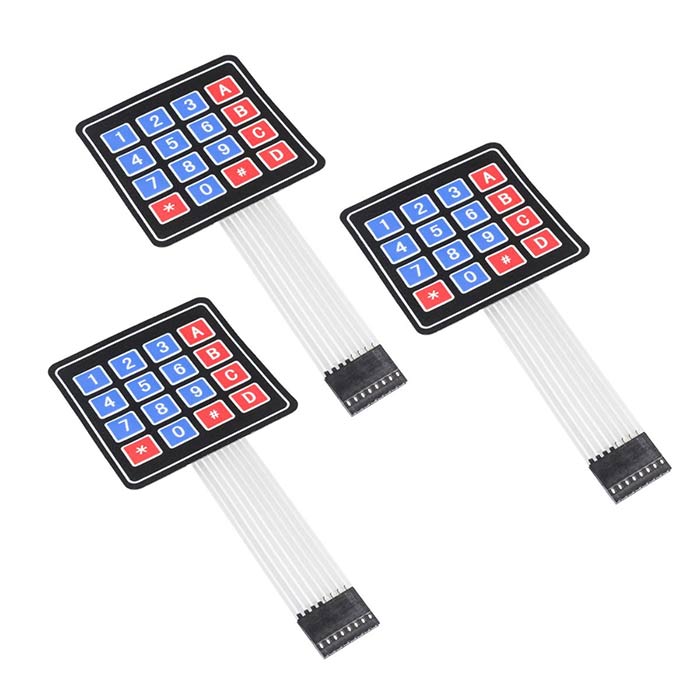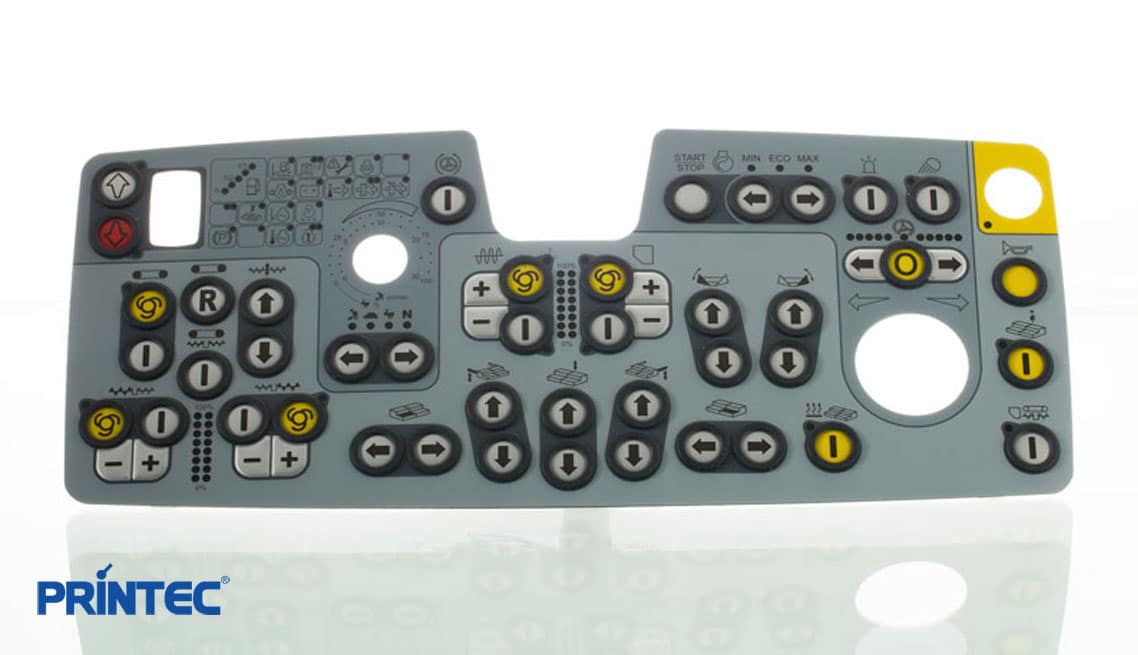When tailored design needs arise, a specialized membrane switch manufacturer is the top choice.
When tailored design needs arise, a specialized membrane switch manufacturer is the top choice.
Blog Article
What to Search for When Selecting a Membrane Change for Your Task
When you're choosing a membrane switch for your task, several essential aspects enter into play. You'll require to think about the materials, style, and just how well it lines up with your brand name. Resilience and functionality are important, however so is the track record of the manufacturer. Comprehending these components can help you make a notified decision-- one that balances quality and expense successfully. Let's explore what you need to think about to guarantee your selection meets all your task needs.
Recognizing Membrane Layer Switch Over Elements
When you dive into the globe of membrane buttons, it's vital to realize the key parts that make them operate. The button usually includes three major layers: the visuals overlay, the spacer layer, and the circuit layer. The graphic overlay supplies the aesthetic user interface, showing switches and icons you need for very easy navigation. Beneath that, the spacer layer assurances there suffices distance in between the circuit and the overlay, allowing the switch to activate without constant pressure.
The circuit layer, frequently made from published conductive inks, produces the electric pathways. When you press a button, the circuit shuts, sending a signal to the device. Recognizing exactly how these layers collaborate helps you select a membrane layer switch that's dependable and fits your project needs. Pay attention to the thickness and material of each layer, as these factors influence longevity and performance in numerous atmospheres.
Product Option and Its Effect
Choosing the ideal materials for your membrane layer switch can considerably impact its performance and long life. The option of substrate, commonly polyester or polycarbonate, affects longevity and versatility. Polyester is a lot more abrasion-resistant, while polycarbonate supplies much better clearness and toughness.
Next, take into consideration the adhesive. It requires to hold up against ecological aspects like wetness and temperature level adjustments. A strong sticky guarantees that your membrane switch stays undamaged gradually.
Do not fail to remember concerning the visuals overlay. The printing technique utilized, whether silkscreen or electronic, influences the button's visual appeals and longevity. High-quality inks will withstand fading and scraping, preserving a specialist look.
Last but not least, think of ecological problems. If your device will certainly be subjected to severe chemicals or severe temperatures, choose materials made to withstand these challenges. Your selections in materials will eventually determine the switch's reliability and customer fulfillment.
Style Considerations for User Experience
Choosing the appropriate products lays the structure for an effective membrane button, but the style also plays a considerable role in customer experience. You'll intend to review how the layout influences functionality (membrane switch manufacturer). Maintain switches and icons intuitive and well-spaced, making it very easy for customers to navigate without complication

Shade and comparison are additionally crucial; guarantee that your style is aesthetically attractive however still practical. High comparison aids individuals conveniently determine switches, especially in low-light conditions.
Last but not least, assess the general visual. A smooth and modern layout can raise individual perception and make your product a lot more enticing. Stabilizing performance with an appealing style will bring about a better individual experience and eventually, a much more successful product.

Ecological Variables and Toughness
When picking a membrane layer switch, you need to take into consideration how it'll perform in numerous atmospheres. Aspects like temperature resistance, wetness and chemical exposure, and mechanical wear can greatly impact its resilience. Understanding these components will help you choose a button that withstands your particular problems.
Temperature Level Resistance Needs
As environmental conditions can vary extensively, understanding temperature level resistance is important for ensuring the sturdiness of your membrane switch. You need to review the temperature level range in which your device will certainly run. Heats can trigger products to break down, bring about failure, while reduced temperature levels could make elements weak and vulnerable to splitting. Make certain to check the specs of the products made use of in the button, like the adhesive and overlay, as they directly impact performance. It's also a good idea to contemplate prospective temperature level variations and their impacts on the switch's reliability. By picking a membrane layer button with ample temperature resistance, you'll improve its life-span and preserve capability in difficult settings. Select sensibly to avoid expensive substitutes down the line.

Wetness and Chemical Exposure
Dampness and chemical direct exposure can significantly affect the efficiency and long life of your membrane layer switch, so it's essential to recognize the atmosphere in which it will certainly be made use of. Constantly speak with the manufacturer's specifications for chemical compatibility to assure your membrane layer switch keeps its functionality over time. By prioritizing moisture and chemical resistance, you can improve the toughness of your button in difficult settings.
Mechanical Deterioration
While you might focus on features like looks and performance in your membrane switch, mechanical wear and tear can significantly affect its performance over time. Frequent pressing can lead to degradation of materials, triggering concerns like tactile responses loss or even switch over failure. Picking a sturdy switch warranties durability and integrity, avoiding expensive replacements and downtime in your project.
Customization Options for Branding
When it pertains to branding your membrane button, modification options are key. You can select design components and shades that mirror your brand name, in addition to certain logo design placement and size to boost visibility. Furthermore, choosing the right products and structures can boost the general look, making your product stand apart.
Design Elements and Shades
A variety of layout aspects and colors can make your membrane layer switch not simply practical yet likewise visually attractive, boosting your brand name identification. When selecting shades, believe about your brand name's combination; they should resonate with your audience and evoke the best feelings. You can also check out different surfaces like matte description or shiny to produce different aesthetic results. Don't neglect about structures; including a tactile component can boost individual experience and make your button stand apart. Take into consideration incorporating custom-made graphics or patterns that align with your brand message. By thoughtfully picking style elements and colors, you not just develop a product that looks wonderful but additionally strengthens your branding continually and efficiently.
Logo Design Positioning and Size
After finalizing your style aspects and colors, the following action is to focus on logo design positioning and dimension. Your logo is an essential element of your branding, so you'll want it to stick out without overwhelming other layout aspects. Review where your logo design will certainly be most noticeable and impactful; common positionings include the leading or center of the button.
Think concerning the size also-- too big and it could outweigh useful elements, as well little and it could get shed. Objective for a balance that permits your logo to be quickly well-known while keeping the total visual appeals. Don't neglect to consider just how the logo lines up with customer communication. This focus to information will certainly boost both performance and brand name identification in your project.
Product and Appearance Choices
Picking the appropriate materials and structures for your membrane button can substantially improve both its capability and visual charm. You'll wish to examine alternatives like polyester or polycarbonate, as they provide durability and resistance to put on. The appearance of the surface also plays a crucial duty; smooth coatings provide a smooth look, while distinctive surfaces can improve grip and responsive comments.
Personalizing the products and textures permits you to mirror your brand name identity efficiently. You could select a matte coating to communicate class or a glossy look for a modern touch. Don't forget regarding shade choices, as lively tones can make your button stand out, while soft tones can produce a more stylish look
Expense vs. High Quality: Finding the Right Equilibrium
When you're handling the choices for membrane buttons, stabilizing expense and top quality can feel overwhelming. You wish to assure that you're obtaining a reputable product without breaking the financial institution. Start by recognizing your project's certain demands. Are you prioritizing longevity or appearances? A lower-cost button might save you money upfront, yet if it endangers performance, you can deal with greater substitute costs later on.
Search check this for producers that use an excellent mix of price and high criteria. Study their online reputation and customer reviews to assess reliability. Sometimes, investing a little bit a lot more in quality materials can save you from future migraines.
Likewise, think about the long-term efficiency and service warranty alternatives. A somewhat a lot more costly switch with a solid service warranty can prove to be a smarter investment. Eventually, it has to do with finding that wonderful spot where you fulfill your budget while assuring your job's success.
Evaluating and Quality Control Protocols
While you might find the best membrane button layout, ensuring its quality via extensive testing protocols is essential for lasting success. Beginning by verifying that the manufacturer complies with industry criteria, such as IPC/WHMA-A -620, to ensure a reputable item. membrane switch manufacturer. You'll want to look for thorough screening methods, including environmental, mechanical, and electric evaluations
Make sure the switches undertake resilience screening, simulating real-world use to identify any prospective failings. Focus on the maker's quality control procedure, which need to include normal examinations and audits.

Don't forget to ask for examples and conduct your very own tests to validate compatibility with your project. Finally, think about just how often the producer updates their procedures; technology in screening can bring about improved quality. By focusing on these testing and quality control protocols, you'll raise the possibility of an effective and long lasting membrane button for your application.
Regularly Asked Questions
How much time Does a Membrane Switch Commonly Last?
A membrane layer switch usually lasts anywhere from 1 to 10 million cycles, depending upon use and environmental variables. You'll wish to think about your details demands to assure it meets your durability requirements efficiently.
Can Membrane Layer Changes Be Fixed if Damaged?
Yes, you can often fix membrane switches if they're harmed, however it usually relies on the level of the damages. Small concerns might be reparable, while a lot more considerable Look At This damage normally requires substitute for correct functionality.
What Are the Common Applications for Membrane Buttons?
Membrane layer switches are commonly made use of in home appliances, clinical gadgets, and vehicle controls. You'll find them in consumer electronics, industrial equipment, and also gaming consoles. Their flexibility makes them suitable for various customer interfaces and settings.
Exist Specific Certifications for Membrane Buttons?
Yes, there are particular certifications for membrane switches. Seek UL, CE, and RoHS qualifications to guarantee security and compliance. These accreditations suggest the button fulfills market criteria for quality and environmental safety and security.
Exactly how Do I Make Sure Correct Installment of a Membrane Layer Switch Over?
To ensure appropriate installment of a membrane button, tidy the surface completely, align it very carefully, and apply even stress. Follow producer guidelines for sticky curing time to maximize sturdiness and performance.
Conclusion
When selecting a membrane button for your job, maintain these key variables in mind: focus on resilient materials, focus on easy to use style, and consider personalization for your brand name. Equilibrium cost and top quality by looking into reputable makers with solid high quality assurance methods. By very carefully evaluating these facets, you'll assure your membrane button not just meets your project needs yet likewise enhances customer experience and shows your brand name identity properly. Make an informed selection, and your project will grow!
Report this page